2008 Ski-Doo TNT

Lighter, more powerful and more fun than… well, an MX Z 550X.
Up to now, if you wanted a snowmobile that you could take out on the trails and toss around, you had few choices. Most of those choices would be fan-cooled models with low-horsepower engines and low-end equipment. But a couple of worthwhile lightweight choices have been available.
Engine Type:Horizontal In-line
Cylinders:2
Engine Stroke:2-Stroke
Valve Configuration:Reed Valve
Displacement:597 / 36.4
Starter:Pull
Turbocharged:No
View Full SpecOne is Ski-Doo’s MXZ 550X and the other would be Yamaha’s new Phazer.
For 2008 you can add a third choice, the Ski-Doo MXZ TNT. With a manufacturer’s suggested retail price of US$7,649, it lists for $50 more than the Phazer RTX, but nearly US$1,500 more than the MXZ 550X. You can see that the TNT won’t be a first pick based on price, but we think it should be the first pick for fun when comparing the three.
As the owner of a Ski-Doo MXZ 550X, this writer needed an impressive test ride to place the TNT ahead of the fan-cooled trail toy. He got it. Even when you toss in the Yamaha Phazer RTX.
All the things that we like about the fan-cooled MXZ are bettered in the ’08 TNT. What we truly couldn’t believe was how light the TNT was! Hey, come on. The fan-cooled MXZ should be lighter. It’s air-cooled, not liquid-cooled. How did Ski-Doo undercut the 550X’s weight by 35 pounds? Just for the record, the TNT is 90-lbs lighter than Yamaha’s Phazer RTX.
Strong On-Trail Performer
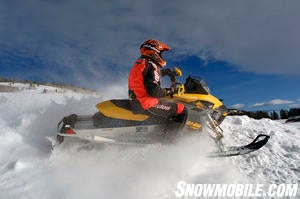 The TNT has an exceptional power-to-weight ratio.
The TNT has an exceptional power-to-weight ratio.
The TNT comes with the lesser-powered of Rotax’ 600cc twins. Measuring 597cc, this Rotax Type 593 series engine features reed valve intake for its dual 40mm carbs and a RAVE exhaust system. This basic TNT powerplant makes 103 horsepower. Compare that to the fan-cooled twin’s power of 57 hp. Then you should also consider the Phazer’s high-revving, 80-horepower, liquid-cooled twin for further comparison.
When you look at weight and power, the TNT looks pretty darn good. What really seals the deal in favor of the all-new TNT is the REV-XP platform. The fan-cooled 550X is based on the older REV design—good, but not as good as the REV-XP chassis. Even with its “moto-cross” looking design, the Phazer won’t match the TNT in power-to-weight. The TNT beats it on two levels—more power and less weight!
New Standard In Price-Value
If Ski-Doo had stopped with the new MXZ replacements based around the REV-XP chassis, snowmobilers would be buzzing about this evolutionary move beyond the popular REV-based Ski-Doos. Apparently that wasn’t good enough for the Quebec-based manufacturer. The TNT sets a new standard in the price-value equation.
Yes, we know, Polaris lays claim to value with its 600cc, 120 hp IQ Shift at US$6,999. Give them the power edge. The power-to-weight advantage is a draw —3.88 lbs per horsepower for the 466 lbs of Shift versus 3.87 lbs per horsepower for the TNT.
Everything else goes Ski-Doo’s way, including handling and on-trail joy.
It’s Different
We knew right away that the TNT was different. The sled has that stealth fighter look with its sharp edges. The look that says, ‘Let’s go for a fast, long ride.’ The new ride-forward position puts you a titch higher in the saddle, but you get more ‘stretch’ room. In technical terms, Ski-Doo raised the seating about two-inches to gain upwards of eight-inches in legroom. The engineers had to relocate the secondary drive clutch vertically over the drive unit, but it works. The Rotax engine sits very low under the pyramidal framework that gives the TNT its rigidity and torsional strength.
All the goodies designed into the REV-XP platform come with the territory. There’s the new REV -XP front suspension with its take-apart, aluminum high-pressure gas shocks and 9-inches of ski travel. The steering is more direct and precise than what you’d find on the REV-based 550X. And, since we test rode the TNT last March; the steering post has been updated with an improved vibration-reduction collar to minimize feedback over rough trails.
The rear suspension is an evolved version of the SC-4 used in the 550X. The TNT’s SC-5 design will give you better front-to-rear weight transfer for outstanding performance in corners and in the rough. The center shock linkage was refined to get smoother action through its stroke and 15-inches of travel are available from the new setup.
On-Trail Feel
On your first sojourn, you probably won’t notice the suspension working as much as you note how light this sled feels. You may even have to find some tight corners and run through them a few times just to feel how different a truly lightweight sled can be. You’ll run the turns in your normal fashion. Then you’ll find yourself blasting deeper into the apex and seesawing the handlebars back and forth to hang out the tail. Then you may even try to run into a turn, hammer the hydraulic Brembo brake to lock the track so you can skid-steer around it. Off the throttle, on the brake, lock the track, off the brake, on the throttle. This is stuff that you would do only by accident (or, actually, accident avoidance) with a heavy-power sled.
These are the things you can do with a lightweight and nimble machine like the TNT. You can play with this sled. You can experiment. You may wish it had another 20 horsepower, but you can play with it just the way it comes. And that smile under your helmet tells you all you need to really know about the TNT. It is a blast!
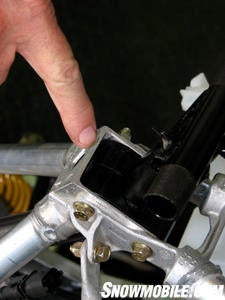 Production TNT models will utilize a rubberized vibration collar in the steering post to damp trail feedback.
Production TNT models will utilize a rubberized vibration collar in the steering post to damp trail feedback.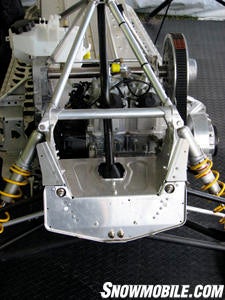 Note the low engine position under the pyramidal framework of the REV-XP platform.
Note the low engine position under the pyramidal framework of the REV-XP platform. More Functional Parts
The TNT is the sum of the lack of its parts. Less weight comes from Ski-Doo engineers figuring out to build in strength and durability while taking out unnecessary avoirdupois and reducing the actual number of parts. They combined functions to reduce total parts. Thirteen pounds came out of the chassis. Revising the front suspension accounted for another seven. The SC-5 rear suspension is eight pounds lighter. The driveline and body gave up eight pounds each.
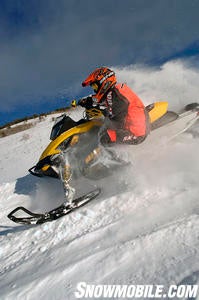 At 399-pounds the TNT can be tossed around on the trail.
At 399-pounds the TNT can be tossed around on the trail.
Ski-Doo engineering realized a weight savings of 41% versus the REV drive shaft when it went to a hydro-formed design. The end result is a larger diameter ribbed hollow tube. The hydroforming process actually resulted in greater strength and reliability.
Remarkable
What Ski-Doo did for 2008 is remarkable. The REV-XP is a worthy successor to the original REV design. You get the benefits of centralized mass with the rider-forward position and improved handling from the new suspensions. The advertised power is more than adequate and the TNT’s power-to-weight ratio is above average thanks to Ski-Doo’s ability to drop weight and bring this production sled in under 400-pounds!
Many manufacturers have talked about creating lighter sleds, but Ski-Doo actually did it. The TNT is proof. We suspect further proof will be strong sales of this all-around first-choice for trail sled of 2008.



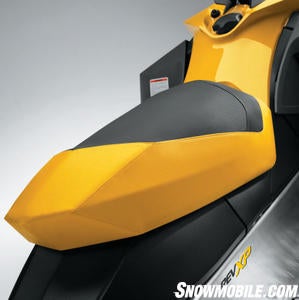
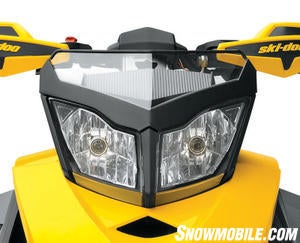





 Your Privacy Choices
Your Privacy Choices